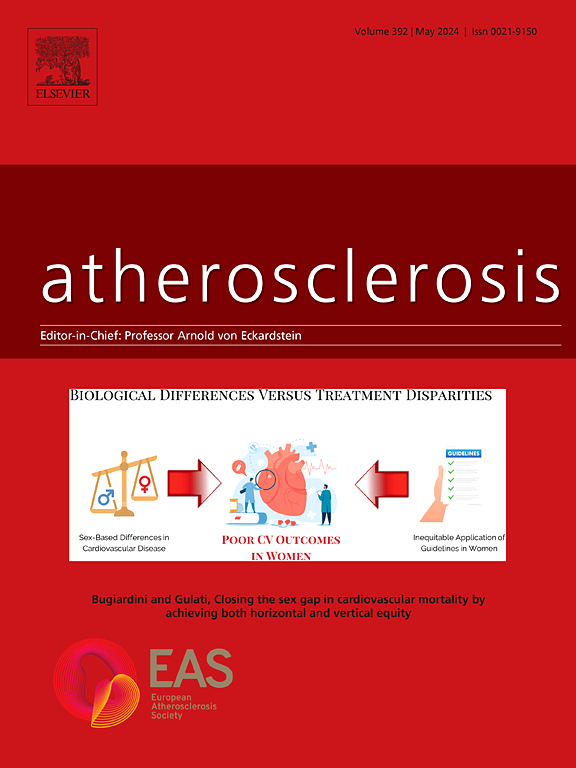Can fast wall shear stress computation predict adverse cardiac events in patients with intermediate non-flow limiting stenoses?
IF 4.9
2区 医学
Q1 CARDIAC & CARDIOVASCULAR SYSTEMS
引用次数: 0
Abstract
Background and aims
Coronary angiography-derived wall shear stress (WSS) may enable identification of vulnerable plaques and patients. A new recently introduced software allows seamless three-dimensional quantitative coronary angiography (3D-QCA) reconstruction and WSS computation within a single user-friendly platform carrying promise for clinical applications. This study examines for the first time the efficacy of this software in detecting vulnerable lesions in patients with intermediate non-flow limiting stenoses.
Methods
This multicentre retrospective study included patients who had coronary angiography showing at least one lesion with borderline negative fractional flow reserve (FFR: 0.81–0.85). In these lesions, 3D-QCA reconstruction and blood flow simulation were performed using the CAAS Workstation WSS prototype (Pie Medical Imaging, Maastricht, Netherlands). Time averaged and multidirectional WSS were extracted across the lesion at every 3 mm segments. The primary endpoint of the study was lesion-oriented clinical events (LOCE), defined as the composite of cardiac death, target lesion related myocardial infarction (MI) or clinically indicated target lesion revascularization.
Results
352 patients (355 lesions) were included in the analysis. Over a median follow-up of 4.1 years, 57 LOCE were recorded. Lesions causing events had a larger area stenosis (AS) [59.4 (54.6–67.7)% vs 52.8 (43.8–60.1)%, p < 0.001], maximum time averaged WSS (TAWSS) [11.56 (8.25–13.64)Pa vs 7.73 (5.41–11.51)Pa, p < 0.001], mean TAWSS at the minimum lumen area (MLA) [9.30 (5.44–11.94)Pa vs 6.19 (3.96–9.00)Pa, p < 0.001] and maximum transverse WSS [0.30 (0.21–0.45)Pa vs 0.23 (0.17–0.32)Pa, p=0.002] than those remaining quiescent. In multivariable models, AS was the only independent predictor of LOCE. Kaplan-Meier curves demonstrated that lesions with elevated maximum TAWSS and AS had a higher rate of LOCE than those with low TAWSS and AS values (26 % vs 7 %, p < 0.001).
Conclusions
For non-flow limiting lesions with borderline negative FFR, fast WSS computation using a dedicated software is feasible and holds potential for cardiovascular risk stratification.

快速壁剪切应力计算能否预测中度非血流限制性狭窄患者的不良心脏事件?
背景和目的:冠状动脉造影衍生的壁剪切应力(WSS)可能有助于识别易损斑块和患者。最近推出的一款新软件可以在一个用户友好的平台上实现无缝三维定量冠状动脉造影(3D-QCA)重建和WSS计算,为临床应用带来了希望。本研究首次检验了该软件在检测中度非血流限制性狭窄患者易损病变中的功效。方法:这项多中心回顾性研究纳入了冠状动脉造影显示至少一个边缘性血流储备阴性病变的患者(FFR: 0.81-0.85)。在这些病变中,使用CAAS工作站WSS原型(Pie Medical Imaging, Maastricht, Netherlands)进行3D-QCA重建和血流模拟。时间平均和多向WSS在病灶上每3mm段被提取。研究的主要终点是病灶导向的临床事件(LOCE),定义为心源性死亡、靶病变相关心肌梗死(MI)或临床指征靶病变血运重建的复合事件。结果:352例(355个病灶)纳入分析。在中位4.1年的随访中,记录了57例LOCE。引起事件的病变有更大的狭窄面积(AS) [59.4% (54.6-67.7)% vs 52.8 (43.8-60.1)%, p结论:对于FFR为阴性的无血流限制病变,使用专用软件快速计算WSS是可行的,并且具有心血管风险分层的潜力。
本文章由计算机程序翻译,如有差异,请以英文原文为准。
求助全文
约1分钟内获得全文
求助全文
来源期刊

Atherosclerosis
医学-外周血管病
CiteScore
9.80
自引率
3.80%
发文量
1269
审稿时长
36 days
期刊介绍:
Atherosclerosis has an open access mirror journal Atherosclerosis: X, sharing the same aims and scope, editorial team, submission system and rigorous peer review.
Atherosclerosis brings together, from all sources, papers concerned with investigation on atherosclerosis, its risk factors and clinical manifestations. Atherosclerosis covers basic and translational, clinical and population research approaches to arterial and vascular biology and disease, as well as their risk factors including: disturbances of lipid and lipoprotein metabolism, diabetes and hypertension, thrombosis, and inflammation. The Editors are interested in original or review papers dealing with the pathogenesis, environmental, genetic and epigenetic basis, diagnosis or treatment of atherosclerosis and related diseases as well as their risk factors.
 求助内容:
求助内容: 应助结果提醒方式:
应助结果提醒方式:


